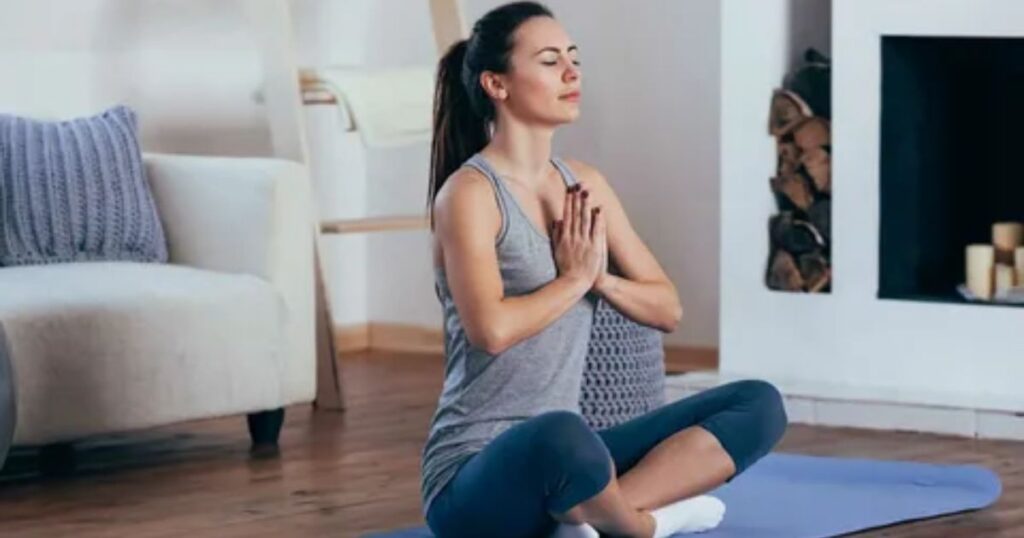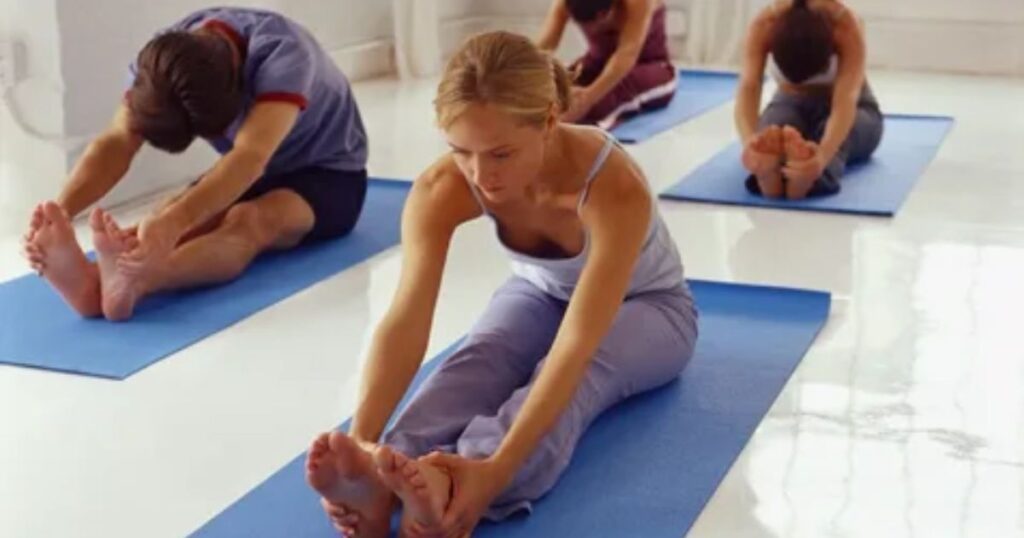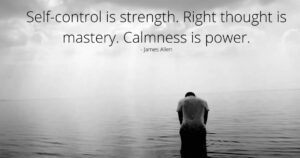Yoga is a mind-body practice that combines physical postures, breath control and meditation. It is beneficial for overall well being, promoting flexibility, strength, and stress reduction. Whether you’re a beginner or experienced, yoga offers a holistic approach to enhance both physical and mental health.
Discover the perfect yoga practice for you. Dive into the world of tranquility and strength as we unravel the mystery of What Type Of Yoga Is Best For Me? Join us on a journey to find your ideal yoga match where mindfulness meets movement, and serenity meets strength. Let’s explore together and unlock the path to your inner zen. Stay with us for a personalized yoga revelation.
Choosing the right type of yoga depends on your preferences and fitness goals. Hatha yoga is gentle and great for beginners, focusing on basic poses and breathing techniques. Vinyasa offers a more dynamic flow, while Ashtanga provides a structured sequence for a challenging practice. Explore different styles to find the one that aligns with your needs and feels enjoyable for you.
Similarities and Differences in Yoga Styles
| Yoga Style | Similarities | Differences |
| Hatha Yoga | Focus on physical postures (asanas) and breath control | Emphasis on slower movements; suitable for beginners |
| Vinyasa Yoga | Synchronization of breath with continuous flow of poses | Dynamic and fast-paced; sequences vary widely |
| Ashtanga Yoga | Structured series of poses in a specific order | Rigorous and physically demanding; follows a set sequence |
| Kundalini Yoga | Aims to awaken spiritual energy at the base of the spine | Involves dynamic movements, chanting, and meditation |
Yoga comes in various styles, each offering unique approaches to physical and mental well-being. Despite their differences, many yoga styles share common principles that unite practitioners worldwide. These shared foundations create a sense of unity among diverse yoga enthusiasts.
- Common Ground
One similarity among yoga styles is the emphasis on breath control and mindfulness. Whether practicing Hatha, Vinyasa, or Kundalini, practitioners focus on conscious breathing to enhance concentration and foster inner peace. Additionally, all yoga styles promote flexibility, strength, and balance, contributing to overall physical health and vitality.
- Divergent Paths
While similarities exist, yoga styles diverge in their techniques and philosophies. For example, the dynamic flow of Vinyasa contrasts with the slow, deliberate movements of Yin Yoga. Similarly, the spiritual emphasis of Kundalini sets it apart from the more physically oriented practices. These distinctions allow individuals to explore diverse aspects of yoga, finding a style that resonates with their preferences and goals.
What Types of Yoga Are There?
There are many different types of yoga, each with its own unique focus and approach. Here are seven types of yoga.
- Hatha Yoga
- Focuses on physical postures (asanas) and breath control (pranayama).
- Suitable for beginners and often serves as a foundation for other yoga styles.
- Vinyasa Yoga
- Emphasizes a flowing sequence of poses, synchronized with breath.
- Dynamic and often challenging, promoting strength, flexibility, and coordination.
- Ashtanga Yoga
- Involves a set sequence of postures performed in a specific order.
- Demanding and vigorous, designed to purify the body and cultivate focus.
- Iyengar Yoga
- Concentrates on precision and alignment of postures.
- Utilizes props like blocks and straps to help achieve proper alignment.
- Kundalini Yoga
- A spiritual and meditative form of yoga.
- Aims to awaken the dormant energy at the base of the spine (kundalini) through various techniques.
- Bikram Yoga
- Involves a series of 26 postures practiced in a heated room.
- Intended to enhance flexibility, detoxification, and mental focus.
- Restorative Yoga
- Focuses on relaxation and stress reduction.
- Involves passive poses, supported by props, held for extended periods to promote deep rest.
These are just a few examples, and there are many more specialized forms of yoga that cater to different needs and preferences. It’s essential to explore and find the style that resonates most with your goals and lifestyle.
Start a Home Yoga Practice

Starting a home yoga practice means doing yoga in the comfort of your own space. It involves following yoga routines or poses without going to a studio or gym. This allows you to create a personalized practice that fits your schedule and preferences. All you need is a quiet space, a yoga mat, and the willingness to explore the benefits of yoga at home.
- Getting Started
Starting a home yoga practice is simple. Find a quiet space in your home, free from distractions. Roll out a yoga mat to create a comfortable space. Begin with easy poses like Child’s Pose or Downward Dog. Follow online videos or use apps for guidance.
- Consistency is Key
Consistency is crucial in a home yoga practice. Set a regular time each day. Start with a short routine and gradually increase the duration. Listen to your body and choose poses that feel good. Celebrate small achievements and enjoy the positive impact on your physical and mental well-being.
What type of yoga is best for everyone?
Choosing the right type of yoga is essential for everyone’s well-being. One popular type of yoga is Hatha yoga, perfect for beginners. This type of yoga focuses on basic poses and breathing exercises, promoting relaxation and flexibility.
For those seeking a more dynamic practice, Vinyasa yoga might be the ideal type of yoga. It involves a fluid sequence of poses synchronized with breath, providing a cardiovascular workout. Another beneficial type of yoga is Kundalini yoga, which combines physical postures, breathwork, and meditation to enhance spiritual awareness.
If you’re in search of a post-yoga activity, you might enjoy the challenge of an After Yoga Crossword clue. Finding the right type of yoga depends on individual preferences and goals. Whether it’s the gentle approach of Hatha, the dynamic flow of Vinyasa, or the spiritual journey of Kundalini, there’s a type of yoga for everyone. Experimenting with different styles can help individuals discover the one that best suits their needs, promoting overall health and well-being.
To Gain Stability and Increase Mobility Try Iyenar Yoga
Iyengar Yoga is a unique practice that focuses on achieving stability and improving mobility. In this form of yoga, precise alignment is emphasized, allowing individuals to build a strong foundation for their poses.
The use of props, such as blocks and belts, in Iyengar Yoga helps individuals of all levels to attain proper alignment. This not only enhances the effectiveness of each pose but also reduces the risk of injury, providing a safe and supportive environment for practitioners.
By incorporating Iyengar Yoga into your routine, you can experience increased flexibility and balance. The emphasis on alignment and the use of props make this style accessible to everyone, making it an excellent choice for those looking to improve their overall physical well-being and find stability in their practice.
How Do I Choose The Right Yoga For Me?
Choosing the right yoga for you depends on your goals and preferences. If you seek relaxation and stress relief, consider Hatha or Yin yoga. For strength and flexibility, try Power or Ashtanga yoga. Explore different styles to find what resonates with your body and mind.
Consider your fitness level and any health concerns. Gentle yoga is great for beginners, while Vinyasa or Bikram may suit those seeking more intensity. Listen to your body and choose a practice that aligns with your current abilities. It’s essential to start at a comfortable level and gradually progress.
Attend trial classes or watch online videos to get a feel for different yoga styles. Pay attention to the instructor’s teaching style and the atmosphere of the class. Finding the right yoga involves experimentation. Trust your instincts and select a practice that brings you joy, relaxation, and aligns with your overall well-being.
What is the most difficult yoga style?
Yoga comes in various styles each with its own challenges. Among them many practitioners consider Ashtanga Yoga to be one of the most demanding. Ashtanga involves a structured sequence of poses requiring strength, flexibility, and continuous movement. The disciplined nature of Ashtanga can be tough for beginners.
Bikram Yoga, also known as hot yoga, presents another set of challenges. Conducted in a heated room, Bikram Yoga aims to enhance flexibility and detoxify the body. The intense heat, however, can make it physically demanding, and maintaining focus in such conditions adds to the difficulty.
For those seeking a mental and physical challenge, Kundalini Yoga might top the list. It combines dynamic movements, breathwork, and meditation. The emphasis on awakening spiritual energy can be both invigorating and demanding, making Kundalini a unique and often challenging yoga style for those exploring the practice.
What is the most beneficial type of yoga?

Choosing the most beneficial type of yoga depends on personal preferences and health goals. Hatha yoga is great for beginners, focusing on basic poses and breathing exercises. It promotes flexibility and relaxation, making it suitable for stress relief.
For those seeking a more dynamic practice, Vinyasa yoga might be ideal. It involves flowing from one pose to another, enhancing cardiovascular health and building strength. Vinyasa can be energizing and helps improve overall body awareness.
The most beneficial type of yoga varies for each individual. It’s essential to explore different styles and find the one that aligns with your fitness level, goals, and overall well-being.
Best Type Of Yoga For Weight Loss
Yoga is a fantastic way to achieve weight loss goals. Among the various types, Vinyasa Yoga stands out. In Vinyasa, you flow smoothly between poses, keeping your heart rate up. This dynamic style not only burns calories but also builds strength and flexibility. If weight loss is your aim, consider incorporating Vinyasa into your fitness routine.
Additionally, Hot Yoga, like Bikram or heated Vinyasa, promotes weight loss through increased sweat and calorie burn. The intense heat boosts metabolism and helps the body detoxify. However, it’s essential to choose a yoga style that aligns with your preferences and fitness level. Ultimately, finding the best type of yoga for weight loss involves exploring different styles and discovering what works best for you.
Frequently Asked Questions
What type of yoga is best for beginners?
Hatha yoga is great for beginners, focusing on basic poses and breathing techniques to build a strong foundation.
Which yoga style is ideal for stress relief?
Restorative yoga, with its gentle poses and emphasis on relaxation, is effective for alleviating stress and promoting deep calmness.
What type of yoga is best for a rigorous workout?
Power yoga or Vinyasa offers a more dynamic and challenging practice, promoting strength, flexibility, and cardiovascular fitness.
Which yoga style is beneficial for mental well-being?
Mindfulness-based practices like Kundalini yoga or Mindful Hatha can enhance mental well-being through a combination of movement, meditation, and breath awareness.
Is there a yoga style that helps with strength training?
Power yoga or Iyengar yoga emphasizes strength-building through challenging poses and alignment-focused movements, offering a great combination of fitness and mindfulness.
Final Thoughts
Discovering the best type of yoga for you involves a thoughtful exploration of your personal preferences, physical abilities, and wellness goals. It’s crucial to recognize that there is no one size fits all approach to yoga, as each style offers unique benefits that cater to diverse needs.
Consider your fitness level and body requirements. If you seek a gentle introduction to yoga, Hatha or Yin yoga might be ideal. For those desiring a more dynamic and physically challenging practice, Vinyasa or Ashtanga could be the perfect fit. Reflect on your goals whether stress relief, flexibility, or strength building and choose a style that aligns with those objectives.
Don’t hesitate to experiment with different classes and instructors. Attending a variety of sessions will help you pinpoint the style that resonates most with your preferences. The best type of yoga for you is the one that fosters a harmonious connection between your mind, body, and spirit, ensuring a fulfilling and sustainable practice.

Marcus Evergreen, with 8 years of yoga expertise, is the author behind yogahubinfo.com, sharing insights and wisdom in holistic well-being.











